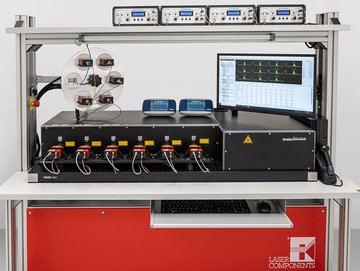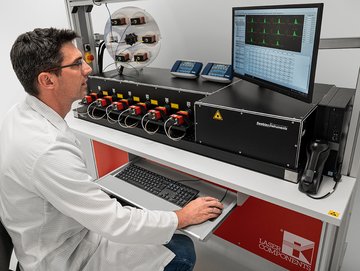COUNT® Characterization Procedure


Characterization Procedure Photon Counting Modules - Introduction
LASER COMPONENTS COUNT® series have emerged as the primary detector choice for demanding low intensity applications, such as LiDAR, dynamic light scattering, fluorescence life-time techniques, and photonic quantum technology. These applications rely on key parameters, such as high quantum efficiency, low dark count rate, low timing jitter and low after-pulsing probability. To meet the demands of our customers for superior performance, quality and reliability, LASER COMPONENTS has teamed up with Swabian Instruments to establish high precision, accurately calibrated testing facilities.
This application note provides technical information on the process used to characterize the COUNT® modules. All measurements are performed on a dedicated test station (Figure 1) that combines ultra-short pulsed diode lasers, computer-controlled motion stages and high precision reference power meters with an exquisite Time-Correlated Single-Photon Counting (TCSPC) system, the Time Tagger Ultra from Swabian Instruments. The Time Tagger’s versatile streaming architecture enables simultaneous signal analysis from 4 lasers and up to 12 COUNT® modules. Fully automatic alignment of the probe laser beam at the free-space channels improves the accuracy and repeatability of the characterization at 4 distinct wavelengths. The test station supports characterization of both the free-space and fiber connectorized COUNT® modules.
Figure 1: COUNT® test setup: fiber-coupled and free-space measurements
Timing Jitter
Beyond Borders
Timing jitter of a COUNT® module is an uncertainty of time difference between the photon arrival time and the output electric pulse. It is measured by accumulating this time difference over many photons into a histogram.
Timing jitter measurement setup consists of a pulsed laser, attenuator that reduces laser pulses to single-photon level, the COUNT® under test, and the Time Tagger operates here as an electronic correlator. The correlator records time differences between the laser synchronization signal and the COUNT® output signal and accumulates a histogram. Since the laser sync and COUNT® output is strongly correlated the histogram has a shape of a peak. The width of this peak contains information about the timing jitter. Note that the width of the correlation peak is also influenced by the timing jitter of the electronic correlator, laser sync signal and the laser pulse duration. The total r.m.s. value of these contributions is given by the following expression:
where:
- σmeasurement = 10 ps - is the r.m.s. timing jitter of the electronic correlator input
- σpulse = 40 ps - is the r.m.s. width of the laser pulse
- σsync = 30 ps - is the r.m.s. timing jitter of the laser sync signal
- σmeasurement ≈ 50 ps - the total r.m.s. jitter of the measurement system
Hence the measurement system is able to measure timing jitter of COUNT® modules down to 50 ps.
Dark Count Rate
Beyond Borders
Dark count rate of a COUNT® module is a rate of false output pulses that are generated in absence of the input photons. This parameter can be easily measured by counting a number of pulses (Nphotons) during a well-defined time interval ΔT:
The Time Tagger provides built-in functionality for the count rate measurements.
After-pulsing Probability and the Deadtime
Beyond Borders
After detecting a photon, a photon counting module requires certain reset time before it can detect a next photon, namely the dead-time. In COUNT® modules the dead-time is a fixed value defined by the reset circuit.
In contrast to the dark counts that occur spontaneously, the after-pulsing effect leads to generation of time correlated false events. For instance, in COUNT® modules such false detection events appear due to release of the trapped charges created by a previous avalanche. The after-pulsing manifests itself as an increased probability of generating a false signal pulse immediately after the dead-time.
The measurement setup for an after-pulsing measurement is essentially the same as shown in Figure 2, except ignoring the laser synchronization signal. The laser pulses of 1 MHz repetition-rate are attenuated such that there is < 1 photon per pulse which means that there is at most 1 photon per microsecond. These photons illuminate the module under test and the Time Tagger accumulates a histogram of the time differences between each of the detected photons. This is essentially an autocorrelation histogram. Both, the deadtime and the after-pulsing probability can be determined from such histogram. Figure 3 shows a sample histogram recorded with a real COUNT® module.
Figure 3: Recorded autocorrelation histogram. The bin at zero time difference contains the number of all recorded events.
The other time bins correspond to the events that occurred with a time delay of up to 500 ns. We do not observe any signal in the region < 42 ns due to the dead time of the COUNT® module.
We perform the characterization of the after-pulsing by recording an autocorrelation histogram for the output signal. An example autocorrelation histogram recorded with a real COUNT® module is shown in Figure 3.
With an ideal detector that has no after-pulsing and no dark counts, one would observe that all counts are added only to the bin at zero time-difference (an event against itself). With a real signal , however, the after-pulsing leads to a distribution spanning a certain time range. Furthermore, a section of the histogram at small time differences remains empty due the deadtime.
The recorded autocorrelation histogram, contains all information necessary for calculation of the integrated after-pulsing probability as:
Where Nap is the number of pulses which are separated in time at most by 500 ns (bins N1…Nm) and N∑ is the total number of all pulses recorded (bin N0). The above-mentioned expression gives an accurate estimate of the after-pulsing probability as long as the dark rates remain << 106 counts/s.c
Photon Detection Efficiency (PDE)
Beyond Borders
Photon detection efficiency is an important characteristic of a photon counting module. It is a probability with which the input photon is converted to a signal pulse. The PDE is defined as a ratio of the detection rate RCOUNT® to the incident photon rate Rin:
Generally, the PDE depends on the material used for light sensing component as well as design parameters, like dimensions of the sensitive area and presence of antireflection coatings of the device input windows.
Figure 4: Sketch of a PDE measurement setup.
Figure 4 shows a setup used for measurement of the PDE. In this setup, the laser pulses are attenuated to a single photon level and sent to the module under test. We determine the photon-rate incident at the detector from the incident light power measurement. In practice, however, the power levels acceptable for COUNT® are too low (< 1 pW) to be reliably measured by a conventional powermeter. Therefore, we use a beam splitter to sample the laser beam power before attenuating it to the single-photon level. In this way we can continuously monitor the incident photon rate at the COUNT® (Rin), which is linearly related to the powermeter reading Pmon as:
where 𝜆 is laser wavelength, h is the Planck constant, c is the speed of light, and K is the factor that relates powermeter reading (Pmon) and the power incident at the COUNT® module (Pin).
Taking into account the dark countrate Rdark and the deadtime Tdead of the COUNT® module it is crucial to accurately determine the factor K. Therefore, we replace the COUNT® module with an accurate and calibrated powermeter and record the readings from both powermeters simultaneously. Usually, the laser power is increased to the level detectable by the calibrating powermeter.
Downloads
Beyond Borders
LASER COMPONENTS France - Your competent partner for optical and optoelectronic components in France.
Welcome to LASER COMPONENTS S.A.S., your expert for photonics components. Each product in our wide range of detectors, laser diodes, laser modules, optics, fiber optics, and more is worth every Euro (€/EUR). Our customized solutions cover all conceivable areas of application: from sensor technology to medical technology. You can reach us here:
45 Bis Route des Gardes
92190 Meudon
France
Phone: +33 (0) 139 595 225
Email: serviceclient(at)


